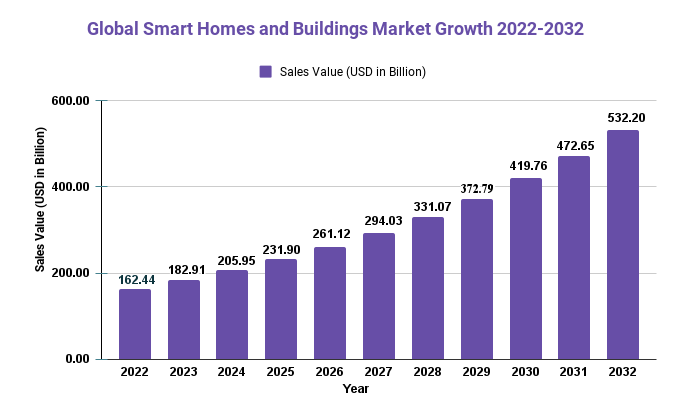Smart Homes and Buildings Market Growing at a CAGR of 12.6% from 2022 to 2032.

Page Contents
Market Overview
Published Via 11Press: The global smart homes and buildings market size is expected to reach USD 532.20 billion by 2032, growing at a CAGR of 12.6% from 2022 to 2032.
The smart homes and buildings market has been growing rapidly in recent years, driven by advances in IoT technology, increased adoption of smart devices, and a growing demand for energy-efficient and sustainable solutions.
North America is the largest market for smart homes and buildings, followed by Europe and Asia-Pacific. The growth of the market in North America is driven by the high adoption of smart home devices, favorable government initiatives, and a growing demand for energy-efficient solutions.
Europe is also a significant market, driven by strict energy efficiency regulations and a growing focus on sustainable building solutions. The Asia-Pacific region is expected to see significant growth, driven by rapid urbanization, increasing disposable incomes, and a growing demand for energy-efficient homes and buildings.
In conclusion, the smart homes and buildings market is growing rapidly and is expected to continue to grow in the coming years. The market is driven by advances in IoT technology, increased adoption of smart devices, and a growing demand for energy-efficient and sustainable solutions. The market is segmented into smart homes and smart buildings, and North America is the largest market, followed by Europe and Asia-Pacific.
Request For Sample Report Here: https://market.us/report/smart-homes-and-buildings-market/request-sample

Regional Snapshot
- North America: North America is the leading market for smart homes and buildings, driven by high adoption of connected devices, supportive government initiatives, and increasing demand for energy-saving solutions. The market is forecasted to keep expanding over the coming years at an annual compound growth rate (CAGR) of 11.9% from 2021-2026.
- Europe: Europe is a significant market, driven by stringent energy efficiency regulations and an increasing emphasis on sustainable building solutions. Estimates predict the market will expand at an annual compound growth rate (CAGR) of 11.5% from 2021-2026.
- Asia-Pacific: The Asia-Pacific region is expected to experience substantial growth due to rapid urbanization, rising disposable incomes, and an increasing need for energy-efficient homes and buildings. The market is projected to expand at a compound annual growth rate (CAGR) of 14.2% from 2021-2026.
- Latin America: The smart homes and buildings market in Latin America is projected to experience a compound annual growth rate (CAGR) of 12.8% from 2021-2026, driven by the rising adoption of connected home devices as well as rising demand for energy-saving solutions.
- Middle East & Africa: The smart homes and buildings market in the Middle East & Africa is on the rise, driven by increased demand for energy-saving solutions and an emphasis on smart city initiatives. From 2021-2026, this market is projected to experience a compound annual growth rate (CAGR) of 11.4%.
Drivers
- Advances in IoT Technology: The growth of the Internet of Things (IoT) has enabled the connection of various devices and systems, creating smart homes and buildings that are energy efficient, secure, and convenient.
- Increased Adoption of Smart Devices: With the rise in popularity of information-gathering devices such as smartphones, speakers, and appliances that provide data, consumers have become more aware of the advantages that smart homes and buildings can provide; such as convenience, energy savings, and enhanced security.
- Rising Demand for Energy-Efficient Solutions: As energy costs continue to increase and environmental concerns worsen, there is an ever-increasing need for energy-saving solutions in homes and buildings. Smart homes and buildings can help reduce energy consumption and carbon emissions through automated usage, optimized heating/cooling systems, managing lighting systems, and other system management.
- Increasing urbanization. With more people moving to cities, there is a growing need for smart homes and buildings capable of providing efficient and sustainable solutions for urban life.
- Education and awareness are increasing: Smart homes and buildings are becoming more popular and consumers are interested in adopting these technologies for a better quality of life.
Restraints
- High Initial Costs: One major barrier for the smart homes and buildings market is the high upfront costs associated with installing smart devices and systems, which may prove an impediment to adoption for many consumers.
- Lack of Standardization: In the smart homes and buildings market, there is a lack of standardization with many different platforms and protocols being used. This can cause compatibility issues between devices and systems, which could be an obstacle to adoption.
- Security Concerns: With the growing number of connected devices and systems in smart homes and buildings, security and data privacy has become more of a worry. This could lead to a lack of trust in the technology, potentially hindering adoption.
- Complexity: Smart homes and buildings can be intricate to set up and manage, which may pose a barrier for some consumers when considering adoption.
- Lack of Awareness and Education: While awareness about smart homes and buildings is growing, many consumers still lack an understanding of their benefits and potential.
Opportunities
- Integration with Renewable Energie Sources: Smart homes or buildings can be connected to renewable energy sources like sun and wind power in order to further reduce carbon emissions.
- Individualization and Customization: Smart buildings and homes can be designed to cater to individual preferences and needs, providing high levels of convenience and comfort.
- Health & Wellness: Smart buildings and homes may incorporate technology to promote their health and well-being, such as smart lighting, air quality sensors, and temperature control. This creates a healthier, cozier living space for residents.
- Smart Cities: Smart homes, buildings, and other smart infrastructures can play an essential role in smart city initiatives. This will promote sustainable living and efficient resource usage.
- Advanced-Data Analytics: Smart homes and buildings generate a vast amount of data that can be utilized for analyzing energy consumption patterns, optimizing performance levels, and even improving user experience.
- Partnerships and Collaborations: The smart home and buildings market presents unique opportunities for collaborations between technology providers and other stakeholders to accelerate innovation and adoption.
View Detailed TOC of the Report | https://market.us/report/smart-homes-and-buildings-market/table-of-content/
Challenges
- Interoperability and compatibility issues: With so many different devices and systems on the market, interoperability and compatibility issues can present a major hurdle for consumers and businesses alike.
- Cybersecurity and Data Privacy Concerns: With an ever-increasing number of connected devices and systems comes increased cybersecurity risks and data privacy worries. This could cause a lack of trust in technology, potentially slowing adoption rates.
- High initial costs: For many consumers and businesses, the high upfront costs associated with installing smart devices and systems can be a substantial impediment to adoption.
- Complexity: Smart homes and buildings can be complex to set up and maintain, which may pose a barrier for some consumers and businesses.
- Lack of Awareness and Education: While awareness about smart homes and buildings is growing, many consumers and businesses still lack an understanding of their advantages and potential.
- Regulatory Challenges: The regulatory landscape for smart homes and buildings is still developing, with numerous different regulations and standards emerging. This can cause uncertainty and confusion for consumers as well as businesses.
Key Market Segments
Type
- Energy Management
- Lighting Control
- HVAC Control
- Safety and Security
- Other
Application
- Government Organizations
- Residential Users
- Commercial Users
- Other
Key Market Players
- Cisco Systems
- Emerson Electric
- Honeywell International
- Siemens
- Robert Bosch
- Control4 Corporation
- Leviton Manufacturing
- United Technologies
Report Scope
| Report Attribute | Details |
| The market size value in 2022 | USD 162.44 Bn |
| Revenue forecast by 2032 | USD 532.20 Bn |
| Growth Rate | CAGR Of 12.6% |
| Regions Covered | North America, Europe, Asia Pacific, Latin America, and Middle East & Africa, and Rest of the World |
| Historical Years | 2017-2022 |
| Base Year | 2022 |
| Estimated Year | 2023 |
| Short-Term Projection Year | 2028 |
| Long-Term Projected Year | 2032 |
Frequently Asked Question
Q: What is the current market size for the Smart Homes and Buildings Market?
A: According to a report by Market.us, the Smart Homes and Buildings Market was valued at USD 162.44 billion in 2022 and is expected to reach USD 532.20 billion by 2032, growing at a CAGR of 12.6% during the forecast period.
Q: What are the key segments of the Smart Homes and Buildings Market?
A: The Smart Homes and Buildings Market can be segmented based on Type (Energy Management, Lighting Control, HVAC Control, Safety and Security, Other), By Application (Government Organizations, Residential Users, Commercial Users, Other), and geography (North America, Europe, Asia-Pacific, Latin America, and Middle East & Africa).
Q: Who are the key players in the Smart Homes and Buildings Market?
A: Some of the key players in the Smart Homes and Buildings Market include Cisco Systems, Emerson Electric, Honeywell International, Siemens, Robert Bosch, Control4 Corporation, Leviton Manufacturing, and United Technologies.
The team behind market.us, marketresearch.biz, market.biz and more. Our purpose is to keep our customers ahead of the game with regard to the markets. They may fluctuate up or down, but we will help you to stay ahead of the curve in these market fluctuations. Our consistent growth and ability to deliver in-depth analyses and market insight has engaged genuine market players. They have faith in us to offer the data and information they require to make balanced and decisive marketing decisions.